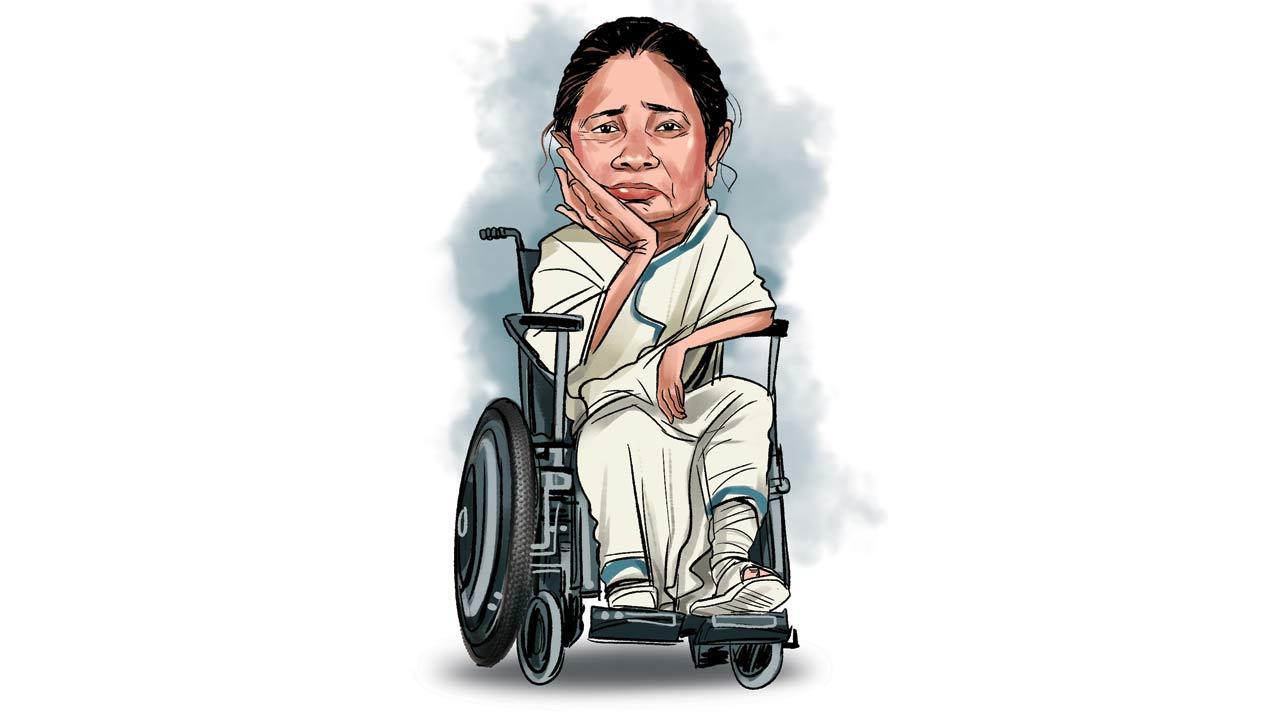Modi’s bid to make the assembly election a referendum on Mamata backfires as one on BJP

Illustration/Uday Mohite
Kolkata was stifling on Saturday night, and not just because of the impending rain. It was the night before the city — and the state it is the capital of — would be put to a litmus test of its famed inclusive character. The Bengal of Tagore versus the Bengal of Syama Prasad Mookerjee.
The air was pregnant with portent and possibilities. Many had been convinced by the hype machine that the state was falling to the BJP juggernaut, finally. “Bengal is in such a hopeless state, let’s see what happens after the BJP takes over,” a newspaper owner from Mumbai said in January this year. Asked how he was so certain of a BJP victory, the person replied: “See how much money they have put in.”
TMC supremo and West Bengal CM Mamata Banerjee visits Kalighat Temple after her party’s win, in Kolkata, on Sunday. Pic/PTI
He went on to cite the onslaught of the central investigative agencies that seems to accompany every BJP state campaign, and how the party was poaching Trinamool leaders. I tried to explain that chief minister Mamata Banerjee was a formidable force whose party had lately been taking quite a few radical steps, like promising universal health insurance coverage in the name of the matriarch of the family, and the Duare Sarkar scheme of setting up government camps across all wards for any and every need of residents.
These “course corrections,” as Trinamool’s poll strategist Prashant Kishor called them on Sunday, seemed to have helped. More importantly for many in Bengal and beyond, the BJP’s brazenly polarising campaign seemed to have backfired.
For example, from Prime Minister Narendra Modi to Union Home Minister Amit Shah to Bengal BJP president Dilip Ghosh — who shares identical views as Kangana Ranaut on “buddhijeevis” [intellectuals] and has some unique scientific insights into gau mutra — the party promised a state where pujas could be held without fear. Ironically, the budget for Bengal’s department of information and cultural affairs has grown spectacularly under the Trinamool, and been used to promote various kinds of traditional festivals.
Polarisation fails spectacularly
Mamata’s lieutenant-turned- challenger, Suvendu Adhikari, only referred to her in terms used by Bengali Muslims, like begum. There were repeated references to Pakistan and Bangladesh.
This politics of communal polarisation failed spectacularly. On Sunday, the BJP did worse in the West Bengal Assembly elections than it did in the state in the 2019 Lok Sabha elections. Then, the BJP had grabbed 40.3 per cent of the vote share in the state, which translated to a projected 121 seats in the Assembly. On Sunday, the BJP could not even get a hundred. Mamata Banerjee’s party emerged the clear choice, even though she seemed to have lost her own poll battle in Nandigram.
“This scenario, of the TMC gaining 200-plus seats, was not there in the wildest predictions,” pointed out Debraj Bhattacharya, a Kolkata-based independent researcher. In April, Bhattacharya argued in a piece in EPW that the Trinamool, riding high on the success of its populist schemes and MSME sector, had damaged itself in 2019 by unleashing violence on the opposition in the panchayat elections the year before, leading to a consolidation of the anti-Trinamool votes.“The Muslim vote is significant in about 100 seats in Bengal,” Bhattacharya said. “If you polarise, you are playing for that many seats less. It is also clear that the anti-BJP vote did not waver or split, and that the BJP tactic of poaching from the Trinamool also mostly failed.”
The results were also a vindication of the #NoVoteToBJP campaign of a section of Left-leaning youth. There was polarisation alright, but it was against the BJP’s brand of identity politics. Even those who might have otherwise voted for the Left or Congress had voted for Trinamool to ensure the anti-BJP vote did not split, said Biswanath Chakraborty, a political science professor who has been crunching poll numbers for a leading Bengali television news channel.
He said Bengal had an inherently liberal ethos, and that it was clear that the state had rejected the “pan-Hindu push of the BJP” and that Mamata’s campaign of “Bengal versus outsiders” had worked.
Sunday washed Kolkata and Bengal with rain and relief as many drew inspiration from Satyajit Ray, whose 100th birthday it was, to exult that a monster had been slain — of the politics of us and them, which was on the hustings for the first time in Bengal. There were many references to Hirak Rajar Deshe, an allegorical film against a dictatorial ruler. “I wish it wasn’t a dry day today though I hardly drink anymore,” said Shaukat Ali, better known in Kolkata as the guitar player Chuku, who has played with many bands in the city. I have known him for many, many years. Sunday was the first time I asked him if he had been made to feel unwelcome because of his religion. “Never in my city have I felt any polarisation, man,” he replied, “before these last six-seven years. The CPM, whatever else, kept the communal thing in check. Now, the TMC is the lesser devil, but don’t get me started on them!”
Sumit Bhattacharya is a Kolkata-based journalist.
 Subscribe today by clicking the link and stay updated with the latest news!" Click here!
Subscribe today by clicking the link and stay updated with the latest news!" Click here!









